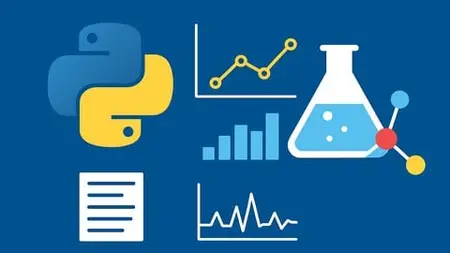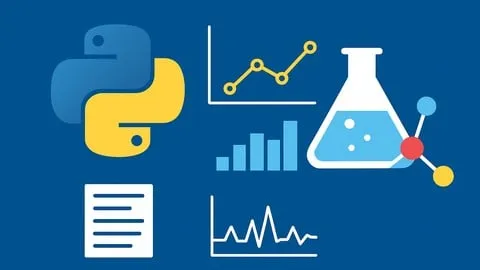Data Analysis & Plotting For Chemistry With Python
Published 8/2025
MP4 | Video: h264, 1920x1080 | Audio: AAC, 44.1 KHz
Language: English | Size: 1.70 GB | Duration: 3h 59m
Published 8/2025
MP4 | Video: h264, 1920x1080 | Audio: AAC, 44.1 KHz
Language: English | Size: 1.70 GB | Duration: 3h 59m
Master data handling, visualization, and real-world chemical analysis with Python—no coding or data science background n
What you'll learn
Learn to efficiently manage, clean, and preprocess chemical datasets using Python.
Import, clean, and manipulate raw chemical data using Python libraries (pandas, numpy, etc.).
Generate professional-quality plots (2D, 3D, interactive) tailored to chemistry problems.
Analyze spectroscopic, thermodynamic, and kinetic datasets to draw research-level conclusions.
Reproduce and interpret data analyses from published chemistry research articles
Apply best practices in reproducibility, documentation, and data-driven research.
Requirements
No advanced coding knowledge is required — we start from the basics and move step by step toward professional-level chemical data analysis.
Description
Chemistry generates data at every level — from titration curves and kinetic measurements to spectroscopy outputs and thermodynamic models. Yet, many chemists struggle to efficiently analyze and visualize this data in a way that leads to clear insights and impactful communication. This course, Data Analysis & Plotting for Chemistry with Python, is designed to bridge that gap.Starting with the basics of Python, you will quickly progress to mastering essential libraries such as NumPy and Pandas, for handling and analyzing chemical datasets. You will then learn to create high-quality plots using Matplotlib ensuring your graphs are not just scientifically accurate but also publication-ready. Every concept is explained in the context of chemistry, with real datasets and case studies drawn from spectroscopy, kinetics, thermodynamics, and analytical chemistry.By the end of the course, you will be able to clean and organize experimental data, perform numerical analyses, and present your results with professional-grade visualizations. Whether you are a student preparing lab reports, a researcher analyzing experiments, or a professional aiming to improve reporting workflows, this course will give you the practical skills to transform raw chemical data into clear, meaningful insights. Moreover, this course will pave your easy way to machine learning where large datasets are handled, analyzed and interpreted.No prior coding experience is required — just curiosity and a willingness to learn.
Overview
Section 1: Introduction
Lecture 1 Introduction
Section 2: Numpy
Lecture 2 setting up a colab environment
Lecture 3 Problems/Limitations of Python Lists
Lecture 4 Tan of 10 values between 0 and 2Pi using list and for loop
Lecture 5 Tan of 10 values between 0 and 2Pi using NumPy
Lecture 6 Generate array of equally spaced values through linspace
Lecture 7 Square of an array
Lecture 8 Some other functions on an array in NumPy
Lecture 9 Problem: Rate constant of a first order reaction through Arrhenius equation
Lecture 10 Equally space array using step size (arange)
Lecture 11 Problem: To solve for particle in one dimensional box
Lecture 12 Two dimensional arrays (arrays of zeros and ones)
Lecture 13 Problem: Electronic configuration of Iron in the form of table using Numpy Zero
Lecture 14 Reshaping of a two dimensional array
Lecture 15 Complex Reshaping of an array
Lecture 16 NumPy array from Function
Lecture 17 Indexing of an array
Lecture 18 changing an item in an array
Lecture 19 some other functions in indexing and slicing of an array
Lecture 20 Reversing an array
Lecture 21 Mean, standard deviation of array
Lecture 22 max min argmax argmin of an array
Lecture 23 columnwise indexing, argmax, …..
Lecture 24 Compound Indexing of an array
Lecture 25 Masking of an array
Lecture 26 Applying condition on an array
Lecture 27 Math vs numpy for an operation on an array
Lecture 28 multiplication and divisions of an array with another one
Lecture 29 Math operation (addition, multiplication division) on arrays of diff dimension
Lecture 30 Math operation (addition, multiplication division) on arrays of same dimension
Lecture 31 NumPy Vectorize operation for a function
Lecture 32 Opening a file with NumPy
Lecture 33 Save Ionization potential data into a csv file using NumPy
Lecture 34 arguments in opening a file suing NumPy and dealing with empty numbers
Lecture 35 genfromtxt and loadtxt options to open a file
Section 3: Pandas
Lecture 36 Limitation of NumPy in handling strings in data
Lecture 37 Panda Series of melting points of the first five elements and the indexing
Lecture 38 Panda Series from a dictionary of melting points and indexing by elements
Lecture 39 Pandas dataframe of AN, AM, d, mp and bp of elements
Lecture 40 Table of properties of elements using Pandas Dataframe index and column
Lecture 41 Modifying dataframe and selectively printing a property from a dataframe
Lecture 42 Indexing of a dataframe (loc)
Lecture 43 Indexing of a series of heat of combustion of alkenes
Lecture 44 heat of enthalpies in kJ per gram by dividing series with molar mass
Lecture 45 Performing a boolean test on a series and to find an item in the series
Lecture 46 Sorting of a series by index and value
Lecture 47 Exporting the elemental propertes to a csv file and read from it.
Lecture 48 Reading a pdb file as a table using Pandas and the arguments in opening a file
Lecture 49 Exporting the pdb data to csv and excel using Pandas
Lecture 50 Adding the properties of element to a dataframe by appending or by adding series
Lecture 51 Droping an entrie row or column from a dataframe
Lecture 52 Merging two dataframes
Lecture 53 Generating a table of proton and neutrons of tranition metals
Lecture 54 Enthalpy and entropy of fusion of transition metals using Pandas
Section 4: Plotting of a spectrum through MatPlotLib.PyPlot
Lecture 55 Plot to show Solubility of a compound in methanol as a function of temperature
Lecture 56 Modifying a plot by changing color, marker, line width etc
Lecture 57 A ombined plot of solubliities of comp A and B and export the plot in PNG formt
Lecture 58 bar plot of ionization energies and electron affinities of first 10 elements
Lecture 59 scatter plot of alcohol contents againts alkalinity of ash and proline content
Lecture 60 Histogram of ionization potentials of elements
Lecture 61 STEM Plot of cosine of radians from 0 to 15
Lecture 62 Pie chart of natual abdundances of 8 most abundant elements in earth crust
Lecture 63 step plot of natual abdundances of 8 most abundant elements in earth crust
Lecture 64 Plotting more than one subplots in a figure
Lecture 65 Plotting more than one subplots in a figure- A second approach
Undergraduate & Graduate Chemistry Students who want to strengthen their data handling and analysis skills.,Researchers & Academics aiming to make sense of experimental datasets and present results with clarity.,Laboratory Professionals seeking to streamline data processing and reporting.,Aspiring Computational Chemists who want a smooth entry point into Python before moving into advanced simulations.,Industry Scientists working with spectroscopy, kinetics, thermodynamics, or analytical chemistry data.,Educators who want to integrate modern data analysis workflows into teaching and research supervision.



